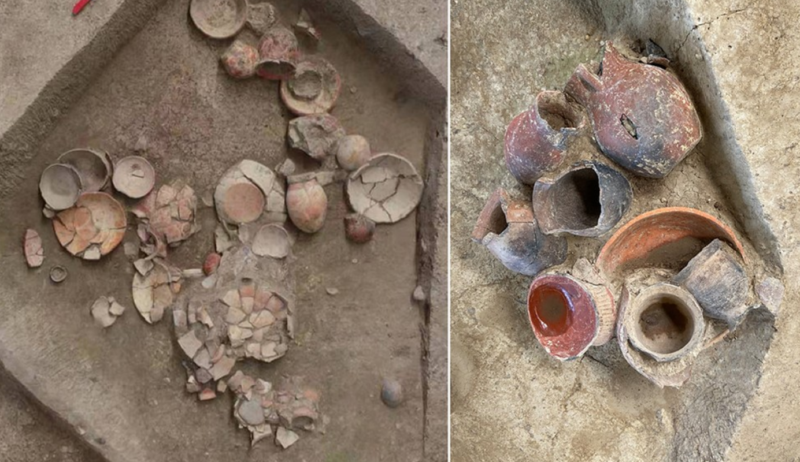Drink up —
The world’s oldest painted pottery may have been for drinking beer at a funeral.
Kiona N. Smith
–

Wang et al. 2021
At a 9,000-year-old burial site in China called Qiaotou, archaeologists recently unearthed a number of ceramic vessels. Some of the vessels were shaped like the long-necked, round-bellied bronze pots that people used for alcoholic drinks millennia later. And that made Dartmouth College anthropologist Jiajing Wang and his colleagues wonder whether these earlier clay versions might have once held beer, too.
Bits of the residue left inside eight of the 13 pots turned out to contain phytoliths (fossilized plant remains) from rice, tubers, and a plant called Job’s tears. Starch molecules in the residue showed signs of being heated and fermented. Wang and his colleagues also found yeast and mold, key ingredients in fermentation.
“Our results revealed that the pottery vessels were used to hold beer, in the most general sense—a fermented beverage made of rice, a grain called Job’s tears, and unidentified tubers,” said Wang. “This ancient beer, though, would not have been like the IPA that we have today. Instead, it was likely a slightly fermented and sweet beverage, which was probably cloudy in color.”
“A drink to the living, a toast to the dead”
This cloudy, sweet rice beer would have been the product of a considerable amount of work. Around 9,000 years ago, people in southern China were just starting to farm rice. The Shangshan culture had seen its people settling in villages, but most of them still relied on hunting and foraging for much of their food. Evidence from other archaeological sites tells us that tubers and acorns were the staples of most people’s diets. Rice appears to have been a luxury crop at the time, and rice beer—considering the extra effort and time required to make it—would have been reserved for very special occasions.
In this case, someone buried these drinking vessels in several “pottery pits” dug into a large burial platform—an 80-meter-long, 50-meter-wide, 3-meter-high flat mound of earth surrounded by a 10- to 15-meter-wide, 2-meter-deep ditch. The platform was the final resting place of at least two people, whose skeletons lay near the pottery pits. All this indicates that the special occasion at Qiaotou was probably a funeral or a later ritual to honor the dead.
The people who attended the ritual at Qiaotou had their rice-and-tuber beer in vessels befitting the occasion. The ceramics found in the platform were finely made and decorated with a white slip formed by an outer layer of white clay. A few of them had been painted with abstract patterns of lines and dots, making the Qiaotou drinking vessels the oldest painted pottery that archaeologists know of.
This is an example of one of the long-necked drinking vessels, along with images of the microscopic traces of ancient beer found inside.
Wang et al. 2021Wang and his colleagues say these vessels may be the oldest known painted pottery in the world.
Wang et al. 2021
Brewing with mold
The dried residue of ancient beer was still stuck to the insides of some of those vessels 9,000 years later, offering a friendly reminder that if you don’t wash your dishes, future archaeologists will probably know. That’s especially true if you’re drinking something like early beer.
“Prehistoric brews are likely akin to a porridge that contains insoluble materials, including starches and other plant additives not fully digested during the brewing process,” explained Wang and his colleagues. “These residue materials are useful for identifying alcohol-related artifacts.” Wang and his colleagues compared the starch molecules, phytoliths, and bits of fungi to a database of Asian plants, another database of microbes, and starches produced by the researchers’ own experiments with ancient brewing techniques.
The mold in particular offered an important clue about how the Shangshan people made their beer. Traces of mold found in the drinking vessels from Qiaotou matched two species that help kick-start the brewing process in modern sake.
To turn a grain like barley, rice, or wheat into a beer, you need some chemistry to happen. First, enzymes have to convert the starches in the grain into sugars. Next, yeast has to turn those sugars into alcohol and (usually) carbon dioxide. Certain species of mold added to the mix can help start both of those processes. Qiaotou is now the world’s oldest evidence of people using mold starters to make beer.
Wang speculated about how the first mold starters were put to use by humans, saying, “If people had some leftover rice and the grains became moldy, they may have noticed that the grains became sweeter and alcoholic with age. While people may not have known the biochemistry associated with grains that became moldy, they probably observed the fermentation process and leveraged it through trial and error.”
At another Shangshan site called Jiahu, archaeologists previously found traces of a different beer recipe, which included rice, honey, and fruits. Wang and his colleagues say that more chemical analysis of the beer residues on the Qiaotou vessels may reveal whether the beer at Qiaotou also included honey or fruit.
PLoS ONE, 2021 DOI: 10.1371/journal.pone.0255833 (About DOIs).

